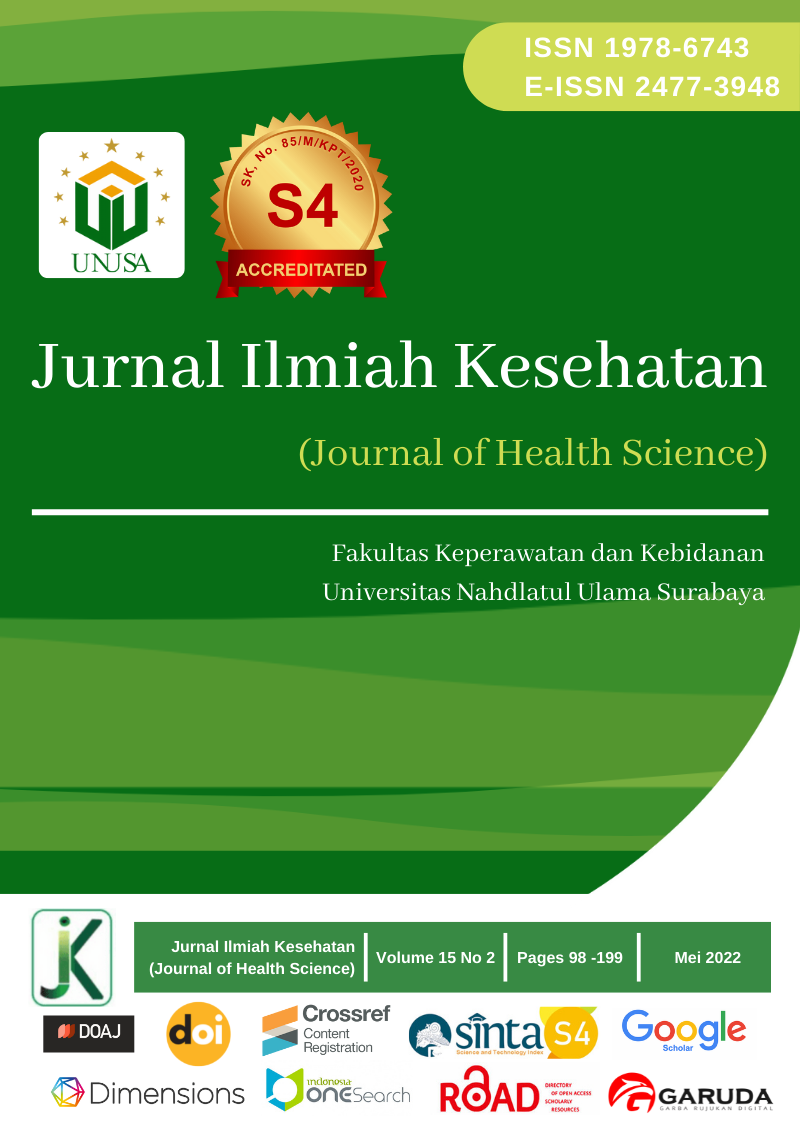Parental Knowledge and Attitude as Associated Factors for Injury Prevention Practice in Preschool Children
Main Article Content
Abstract
Children who like to explore the environment potentially cause injury, so injury prevention is essential. Parental knowledge and attitude influence the incidence of injury in children. This paper analyzes the correlation between parental knowledge and attitude toward injury prevention practice in preschool children. This research was a cross- sectional study. The population was parents who have children schooling in Al - Masithoh 04 Kindergarten. In addition, there were 40 samples with a total sampling method. The independent variables were parental knowledge and attitude, while the dependent variable was injury prevention practice. The instrument utilized questionnaires. A questionnaire for parental knowledge consisted of 24 multiple-choice questions. In addition, there were 14 questions for the parental attitude variable. Injury prevention practices were evaluated using the recall method with 14 questions. The statistical test used the Sommers correlation and the Lambda with a 95% confidence level. Respondents with less parental knowledge had less injury prevention practice (25%). The Sommers D test obtained p=0.001 r=0.447, indicating a positive and moderate correlation between parental knowledge and injury prevention practices. In addition, respondents with negative parental attitudes had poor injury prevention practices (47.5%). The Lambda test obtained p=0.000 r=0.650, meaning a positive and strong association between parental attitude and injury prevention practice. Parental knowledge and attitude correlate with injury prevention practice in preschool children. There should be an effort to improve parental knowledge, especially about the dangers of injury and its prevention.
Downloads
Article Details
Copyright (c) 2022 Mokhtar Jamil, Merisdawati

This work is licensed under a Creative Commons Attribution-ShareAlike 4.0 International License.
References
Atak, N. et al. (2010) ‘A household survey: Unintentional injury frequency and related factors among children under five years in Malatya’, Turkish Journal of Pediatrics, 52(3), pp. 285–293.
Ikhlasul, A., Istadi, Y. and Wijayanti, K. (2015) ‘Hubungan antara Tingkat Pengetahuan dengan Sikap Ibu dalam Pencegahan Keracunan pada Anak Usia 1-5 Tahun’, Jurnal Kedokteran dan Kesehatan Kedokteran, pp. 112–115.
Indarwati, R. D. (2011) ‘Hubungan antara Pengetahuan dan Sikap Orang Tua tentang Bahaya Cedera dan Cara Pencegahannya dengan Praktik Pencegahan Cedera Pada Anak Usia Toddler di Kelurahan Blumbang Kecamatan Tawangmangu Kabupaten Karanganyar’, GASTER, 8(2), pp. 750–764.
Jamil, M. (2020) ‘Hubungan Pengetahuan Dan Sikap Orang Tua Dengan Praktik Pencegahan Cedera Pada Anak Pra Sekolah’, Jurnal Surya, 12(1), pp. 16–25. doi: 10.38040/js.v12i1.97.
Kusbiantoro, D. (2014) ‘Praktik Pencegahan Cedera Pada Anak Usia Toddler Ditinjau Dari Pengetahuan Dan Sikap Orang Tua Tentang Bahaya Cedera Di Desa Kembangbahu Kecamatan Kembangbahu Kabupaten Lamongan’, Jurnal Surya, II, pp. 32–40.
Kuschithawati, S., Magetsari, R., & Ng, N. (2007) ‘Faktor Risiko terjadinya cedera pada anak usia sekolah dasar’, Berita Kedokteran Masyarakat, 23(3), 131.
Notoatmodjo, S. (2010) Ilmu Perilaku Kesehatan. Jakarta: Rineka Cipta.
Nursalam (2016) ‘Metodologi Penelitian Ilmu Keperawatan’. Salimba Medika.
Nursalam, N. (2019) Konsep dan Penerapan Metodologi Penelitian Ilmu Keperawatan (87). Stikes Perintis Padang.
Rahma, N. A. et al. (2020) ‘Faktor Risiko Terjadinya Kecacingan pada Anak Usia Sekolah Dasar’, The Indonesian Journal of Public Health, 23(3), pp. 131–141.
Widyaningsih, A. (2014) ‘Hubungan perilaku ibu dalam pencegahan cedera dengan kejadian cedera balita di serangan yogyakarta’, Jurnal Keperawatan, p. 60.





